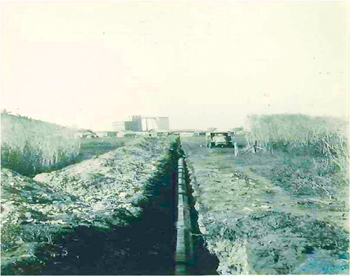A History of Bozeman’s Water System, Part II
This article is the second in a series of three articles telling the history of Bozeman’s water system. Part I can be found in the June Bozeman Magazine.
By 1905 nearly 23 miles of wooden and cast iron pipes delivered water from Lyman Springs, in the foothills of the Bridger Mountains, to Bozeman as far south as College Street and as far west as South 10th Avenue.
Bozeman’s population grew by half in the first decade of the twentieth century, from 3,400 in 1900 to 5,100 in 1910. Seed pea canneries, the Lehrkind Brewery and the Story Milling Company offered jobs which created demand for new housing. Bozeman’s Main Street grew an entire block of new brick commercial buildings between Black and Tracy Avenues. Known as the Progressive Era, government services and infrastructure expanded during this period as well.
The water system depended on gravity to force piped water from the Lyman Reservoir (elevation 5,030) under the East Gallatin River and uphill to Main Street (elevation 4,820), and then to sinks and bathtubs in the Bozeman Hotel, another 80 feet in the air. The Bozeman Hotel’s elevator was also hydro-powered, leaving late summer visitors with an unpleasant four floor hike when a dry spell reduced water pressure.
A line ran to the Montana State College campus (elevation 4,915). As the campus and nearby residential neighborhoods grew demand outpaced the system’s ability to deliver water for domestic use and fire suppression. Water pressure for baths, toilet flushing and running the washing machine was unreliable and it became common for the City to ban watering lawns in late summer.
To alleviate the issue City Engineer C.M. Thorpe sought out alternative water sources south of town, which could run downhill to service College Hill, also called College Heights. In 1908 Thorpe reported on Mardis Springs, located 2.75 miles south of town near the modern intersection of South 3rd Avenue and Goldenstein Lane. Thorpe found no well defined spring, but that the water rose over an area of swampy ground and offered a flow of 18 to 22 inches. Though Mardis Springs wasn’t perfect, Thorpe thought an ample water supply could be developed in the area.
On September 1, 1910 the new City Engineer Will Hartman alerted the City Council that “within the last two weeks the [Lyman Creek] reservoir has on several occasions been empty or nearly so, and the City had very poor or no fire protection.” Hartman recommended immediate action to enlarge the reservoir as well as acquiring additional water rights in either Church Creek or other sources to the south.
At Hartman’s recommendation the reservoir was expanded fourfold in 1911, to a dimension of 255 feet wide by 170 feet long and a depth of 29 feet. Once expanded, the concrete-lined reservoir stored over 13,000 yards of water for municipal users.
As with Lyman Creek, the private sector initiated development of water resources in the Bozeman Creek drainage for productive uses. Located south east of Bozeman in the Gallatin National Forest the drainage was primarily under the control of the Department of Agriculture’s Division of Forestry (later renamed the Forest Service) at the turn of the 20th century.
Of the three organizations which formed to control the drainage, the Bozeman Creek Reservoir Company was the most permanent. Incorporated in March 1901 with capital stock of $10,000 consisting of 20 shares of $500 dollars each, the Bozeman Creek Reservoir Company filed a water rights appropriation claiming all of the surplus waters of Mystic Lake and Bozeman Creek not owned by prior appropriators. They also claimed the right to construct a dam and create a reservoir. With an eye towards Bozeman, the company specified that the waters could be delivered to any municipality in Gallatin County.
The company constructed a dam at Mystic Lake in 1903 and 1904 under the supervision of S. Fortier, the director of the Agricultural Experiment Station at Montana State College. Fortier, a Civil Engineer, frequently extolled the necessity and virtues of irrigation in improving Montana’s agricultural production. City Engineer CM Thorpe was the Construction Engineer. Thorpe frequently subsidized his salary as Engineer for the City by moonlighting in the private sector. Using skills honed as a Surveyor for Gallatin County, Thorpe surveyed Mystic Lake in preparation for construction of the 43 foot high and 400 foot long dam.
The City continued to seek additional water resources during the early 19teens and quietly purchased four of the shares in the Bozeman Creek Reservoir Company in 1915. Engineer Hartman reported “When the city learned that there were some few shares that were not being used they immediately purchased for of them at $840 each… As soon as the city had purchased these four shares one or two other holders of shares in Mystic Lake wished to sell their shares to the City, but wanted the City to pay them $2,000 per share.”
Infrastructure improvements were needed in order to bring the Bozeman Creek water into the City. In 1916 the City Council asked voters to approve of $235,000 in municipal bonds to “redeem outstanding water bonds, extend, improve and enlarge the present water works system and acquire an auxiliary of additional water works system from Bozeman Creek for the City of Bozeman.”
Members of the City Council came out for and against the bonding measure. Nelson Story, Jr. published an editorial in the Bozeman Daily Chronicle wondering if the Lyman water resources could be expanded. A day later Hartman contradicted Story, writing to the Chronicle that “it would be foolish to spend any more money trying to bolster up the present supply.” Hartman stated bluntly, “there is not enough pressure with our present system, and it is not possible to get it with our present system.”
Advocates for the bonding measure pointed to the community’s desire to retain the agricultural college. The legislature would meet in 1917, they reminded readers, and if Bozeman couldn’t provide adequate fire protection for the present buildings the legislature may refuse to make further appropriations for the college.
The April 1916 election saw 224 votes in favor of the bonds and 132 against; a 92 vote majority for $235,000 in bonding.
As if to confirm the need for additional water resources, the Chemistry Hall on the MSC campus burned to the shell in late October 1916. The City and Campus fire departments used chemical extinguishers in an effort to stop the fire but after recognizing the structure was doomed turned their attention to preventing the spread of fire to Montana Hall.
Installation of a cast iron water main from Mystic Lake along Sourdough Road and into Bozeman began in 1917 and was part of an overall water distribution system upgrade in the late 19teens and early 1920’s. The project included replacement of the wooden water main from Lyman Creek into Bozeman and other improvements.
The August article will focus on Bozeman’s continued demand for water and expansion into the Middle Creek/ Hyalite drainage beginning in the 1930’s.
Courtney Kramer is a proud graduate of MSU’s History Department and serves as the City of Bozeman’s Historic Preservation Officer. She may be contacted at the City Planning Office, 406-582-2260 or via email at ckramer@bozeman.net. More information about Bozeman’s historic districts is available at www.preservebozeman.org



